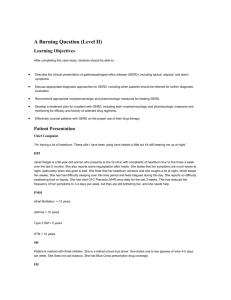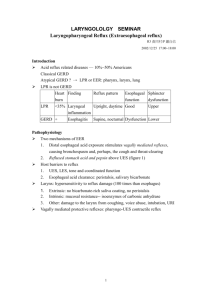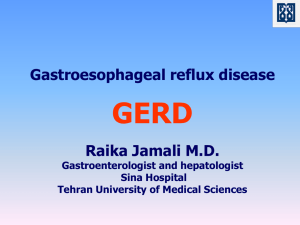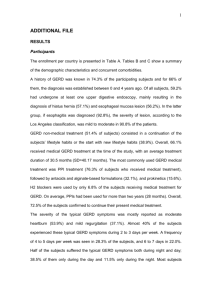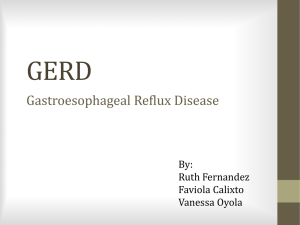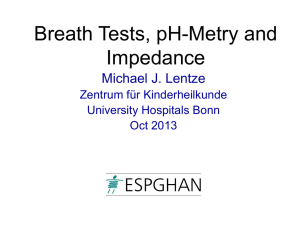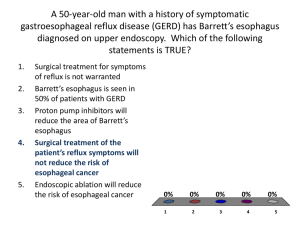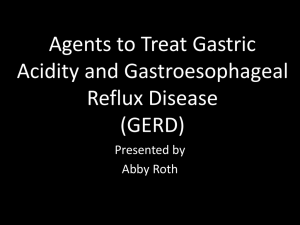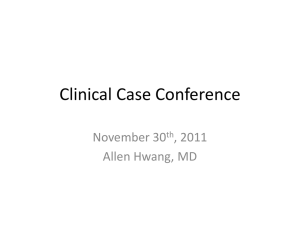Gastroesophageal Reflux Disease: Beyond Heartburn
advertisement
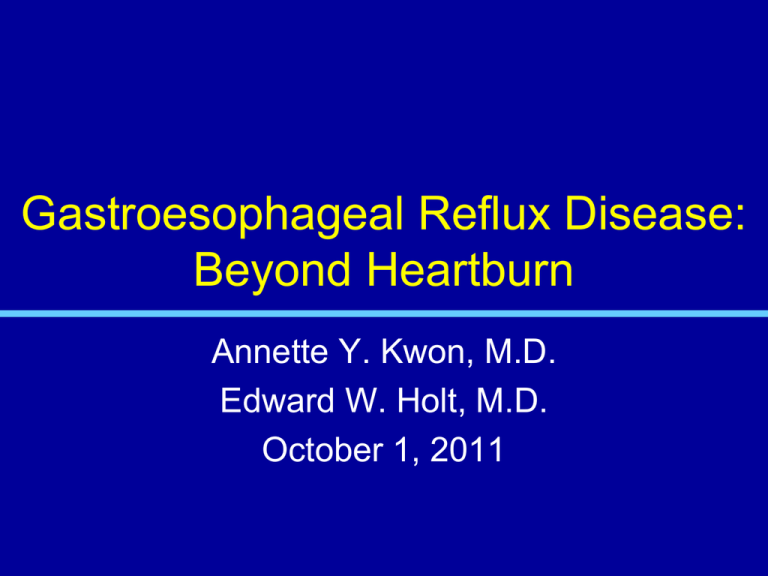
Gastroesophageal Reflux Disease: Beyond Heartburn Annette Y. Kwon, M.D. Edward W. Holt, M.D. October 1, 2011 Gastroesophageal Reflux Disease • • • • • • The scope of the problem What is the working definition? What is the pathophysiology? What is laryngopharyngeal reflux? What is the current diagnostic strategy? What is a rational treatment strategy? Gastroesophageal Reflux Disease • Most common GI diagnosis for outpatient visits • 14-20% of adults affected in US • Rising incidence of esophageal adenocarcinoma with 8000 incidence in 2004 (2-6 fold increase in 20 yrs) GERD: Montreal Definition • A condition which develops when the reflux of stomach contents causes troublesome symptoms and/or complications – > 2 heartburn episodes/week – Adversely affect an individual’s well being From Vakil N et al. Am J Gastroenterol 2006;101:1900-20. GERD: Complications Kahrilas P. N Engl J Med 2008;359:1700-1707 Montreal Classification of GERD From Vakil N et al. Am J Gastroenterol 2006;101:1900-20. Montreal Classification of GERD Pathogenesis of GERD LES Hiatal Hernia Decreased Salivation Impaired Tissue Resistance Impaired Esophageal Clearance Decreased LES Resting Tone Duodenum Delayed Gastric Emptying Bile Reflux Paradox in GERD: Imperfect correlation between symptoms and endoscopic features Barrett’s esophagus Esophagitis Cases (%) 16/1000 (1.6%) 155/1000 (15.5%) % with GERD symptoms 40% 33% From Ronikainen J et al. Gastroenterology 2005;129:1825-31. Paradox in GERD: Imperfect correlation between symptoms and esophageal adenocarcinoma • Typical GERD symptoms in only 60% of patients with cancer • 453/589 patients with cancer had Barrett’s on pathology • 23/63 with prior EGD had prior Barrett’s diagnosis • Laryngopharyngeal reflux (LPR) symptoms more common than GERD symptoms in patients with cancer Diagnosis GERD Diagnostic Approach ACG Guidelines • If history typical for uncomplicated GERD, initial trial of empiric therapy (including lifestyle modification) is appropriate DeVault KD et al. Am J Gastroenterol 2005;100:190-200. Role of Endoscopy in Management of GERD: ASGE Guidelines • • • • • • GERD despite therapy Dysphagia Odynophagia GI bleeding/anemia Mass, stricture or ulcer on imaging study Recurrent symptoms after antireflux surgery From Gastrointest Endosc 2007;66:219-24. Role of Endoscopy in Management of GERD: ASGE Guidelines • Screening for Barrett’s: – controversial with no clinically proven decrease in mortality with screening and surveillance programs • Persistent vomiting • Suspected extraesophageal GERD From Gastrointest Endosc 2007;66:219-24. Alternative Diagnosis in GERD • • • • • • • Coronary artery disease Gallstones Gastric /esophageal cancer Peptic ulcer disease Esophageal motility disorders Pill induced esophagitis Eosinophilic esophagitis From Kahrilas PJ. N Engl J Med 2008;359:1700-7. Physiological Testing Helpful in Selected Patients • Identify subtle motility disorders (esophageal manometry) • Demonstrate abnormal exposure to esophageal acid in absence of esophagitis (ambulatory pH monitoring) • Quantifying exposure to acid and reflux events regardless of acidic content to assess correlations with symptoms (combined impedance-pH monitoring) Laryngopharyngeal Reflux (LPR) • LPR results when stomach contents reflux into the posterior pharynx and cause symptoms • 4-10% of ENT visits are GERD related • Significant association with hoarseness • Difference with GERD – Injury threshold lower – Weak acids, weak bases or neutral substances can cause significant injury – Rarely have erosive esophagitis LPR: Reflux Symptoms Index • Within the last month, how did the following probems affect you? – Hoarseness or problem with your voice – Clearing your throat – Excess throat mucus or postnasal drip – Difficulty swallowing food, liquids, or pills – Coughing after you ate or after lying down Hammer. Dig Dis 2009;27:14-17 LPR: Reflux Symptoms Index – Breathing difficulties or choking episodes – Troublesome or annoying cough – Sensation of something sticking in your throat or a lump in your throat – Heartburn, chest pain, indigestion or stomach acid coming up • Rate of 0 to 5 by patients for each question • Score of >13 suggestive of LPR Treatment AGA GERD Practice Guidelines: Lifestyle Modifications • Weight loss should be recommended in all patients • Lifestyle modifications should be tailored to individual circumstances – Elevate HOB if nocturnal symptoms – Avoid precipitating foods • Broad lifestyle changes for all (vs. selected) not recommended From Kahrilas PJ et al. Gastroenterology 2008;135:1383-91. Weight Loss & GERD “Our current treatment goals should move away from allowing our patients to eat through their PPI therapy….” From Pandolfino J. Am J Gastroenterol 2008;103:1355-7. AGA GERD Practice Guidelines: Medication PPI Esophagitis 83% Heartburn 40% H2RA Placebo 52% 8% 15% No major differences in efficacy among various PPIs Twice standard dose modestly effective but significant (NNT 25) Khan M et al. Cochrane Database Sys Rev 2007;2:CD003244 Patients in symptomatic remission (%) GERD Is a Chronic Condition Likely to Relapse 100 No mucosal breaks LA Grade A 80 LA Grade B LA Grade C 60 40 20 0 0 1 2 3 4 Time after cessation of therapy (months) From Lundell LR, et al. Gut. 1999;45:172-180. 5 6 Adverse Events With Up to 1 Year Esomeprazole Treatment Adverse Event % Patients (N=807) Headache 10.3 Diarrhea 9.4 Abdominal pain 9.3 Nausea 6.1 Back pain 5.9 From Maton PN et al. Drug Safety 2001;24:625-35 of Safety Profile of PPIs • Recent epidemiologic associations – C. difficile 2x – Bacterial gastroenteritis 1.5x – Hip fracture 1.4x in age >50 – Plavix interaction…resolved… • Pregnancy – Omeprazole category C but rest of PPI and H2RA are category B GERD Treatment Algorithm: Initial Work Up Initial Assessment Possible patient with GERD or LPR Rule out other causes Coronary artery disease Consider ultrasound if biliary colic suspected Other causes ruled out Typical symptoms No Alarm symptoms Empiric treatment 8-12 weeks Lifestyle modification Dysphagia present Consider barium swallow • LPR requires higher doses for 3 months Referral to GI GERD Treatment Algorithm: Initial Work Up Empiric Treatment Lifestyle Modification Resolution of symptoms Maintain lifestyle modification Titrate to lowest effective maintenace therapy Maintain lifestyle modification On demand therapy If on multiple medications, eliminate one at a time if on twice daily PPI, decrease to once daily x 4 weeks then off • High recurrence rate when therapy discontinued GERD Treatment Algorithm Initial Assessment Patient with Possible GERD Other causes ruled out Typical symptoms No alarm symptoms Presence of alarm symptoms Empiric Treatment for 8-12 weeks Lifestyle modifications Medications Refer to GI Resolution of symptoms Maintain lifestyle modifications Maintain at lowest effective dose Maintain lifestyle modifications On demand therapy as needed No response to treatment Refer to GI EGD (manometry) (pH impedence) EGD (manometry) (pH impedence) Twice standard dose of PPI No response to Treatment Refer to GI EGD (manometry) (pH impedence) Resolution of symptoms Summary • GERD currently classified by Montreal system – Esophageal – Extraesophageal (LPR) • Diagnostic testing – Empiric treatment in uncomplicated cases with typical symptoms – Endoscopy Summary • Diagnostic sequence: –Endoscopy –Manometry –pH studies • Role of screening for Barrett’s esophagus remains controversial Summary • PPIs are cornerstone of therapy – Goal of therapy: lowest dose to control symptoms • Lifestyle changes should be used selectively • Antireflux surgery reserved for nocturnal regurgitation & PPI intolerance Thank you!

